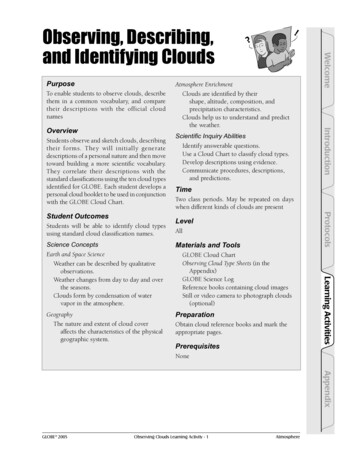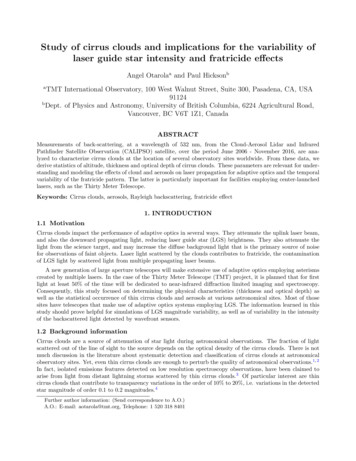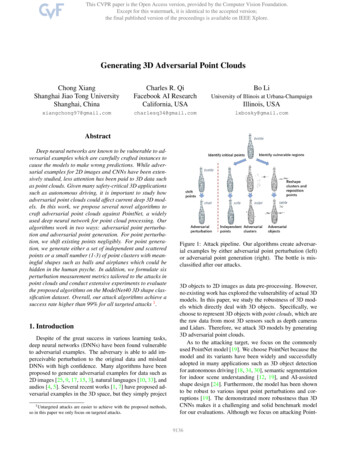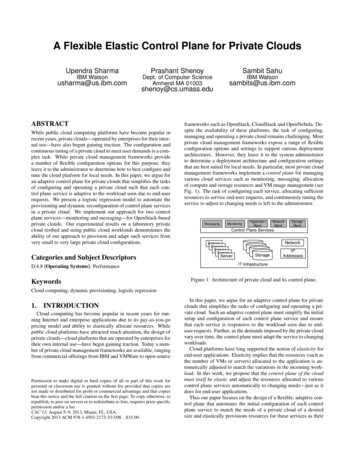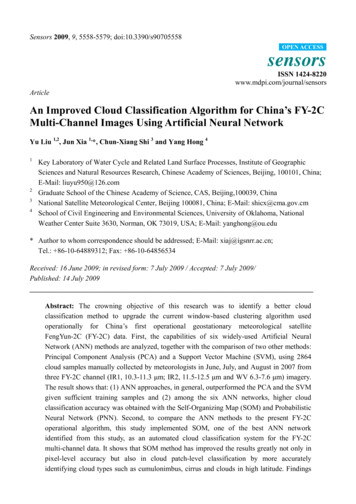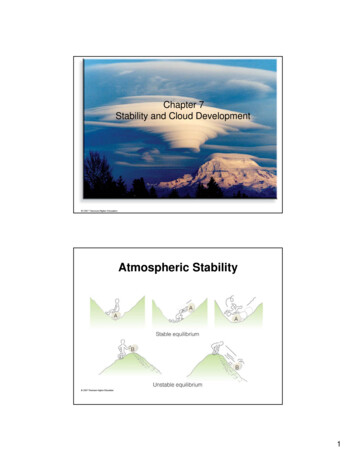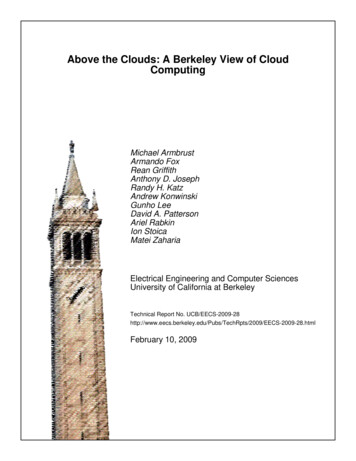
Transcription
Above the Clouds: A Berkeley View of CloudComputingMichael ArmbrustArmando FoxRean GriffithAnthony D. JosephRandy H. KatzAndrew KonwinskiGunho LeeDavid A. PattersonAriel RabkinIon StoicaMatei ZahariaElectrical Engineering and Computer SciencesUniversity of California at BerkeleyTechnical Report No. TechRpts/2009/EECS-2009-28.htmlFebruary 10, 2009
Copyright 2009, by the author(s).All rights reserved.Permission to make digital or hard copies of all or part of this work forpersonal or classroom use is granted without fee provided that copies arenot made or distributed for profit or commercial advantage and that copiesbear this notice and the full citation on the first page. To copy otherwise, torepublish, to post on servers or to redistribute to lists, requires prior specificpermission.AcknowledgementThe RAD Lab's existence is due to the generous support of the foundingmembers Google, Microsoft, and Sun Microsystems and of the affiliatemembers Amazon Web Services, Cisco Systems, Facebook, HewlettPackard, IBM, NEC, Network Appliance, Oracle, Siemens, and VMware; bymatching funds from the State of California's MICRO program (grants 06152, 07-010, 06-148, 07-012, 06-146, 07-009, 06-147, 07-013, 06-149, 06150, and 07-008) and the University of California Industry/UniversityCooperative Research Program (UC Discovery) grant COM07-10240; andby the National Science Foundation (grant #CNS-0509559).
Above the Clouds: A Berkeley View of Cloud ComputingMichael Armbrust, Armando Fox, Rean Griffith, Anthony D. Joseph, Randy Katz,Andy Konwinski, Gunho Lee, David Patterson, Ariel Rabkin, Ion Stoica, and Matei Zaharia(Comments should be addressed to abovetheclouds@cs.berkeley.edu)UC Berkeley Reliable Adaptive Distributed Systems Laboratory http://radlab.cs.berkeley.edu/February 10, 2009KEYWORDS: Cloud Computing, Utility Computing, Internet Datacenters, Distributed System Economics1Executive SummaryCloud Computing, the long-held dream of computing as a utility, has the potential to transform a large part of theIT industry, making software even more attractive as a service and shaping the way IT hardware is designed andpurchased. Developers with innovative ideas for new Internet services no longer require the large capital outlaysin hardware to deploy their service or the human expense to operate it. They need not be concerned about overprovisioning for a service whose popularity does not meet their predictions, thus wasting costly resources, or underprovisioning for one that becomes wildly popular, thus missing potential customers and revenue. Moreover, companieswith large batch-oriented tasks can get results as quickly as their programs can scale, since using 1000 servers for onehour costs no more than using one server for 1000 hours. This elasticity of resources, without paying a premium forlarge scale, is unprecedented in the history of IT.Cloud Computing refers to both the applications delivered as services over the Internet and the hardware andsystems software in the datacenters that provide those services. The services themselves have long been referred to asSoftware as a Service (SaaS). The datacenter hardware and software is what we will call a Cloud. When a Cloud ismade available in a pay-as-you-go manner to the general public, we call it a Public Cloud; the service being sold isUtility Computing. We use the term Private Cloud to refer to internal datacenters of a business or other organization,not made available to the general public. Thus, Cloud Computing is the sum of SaaS and Utility Computing, but doesnot include Private Clouds. People can be users or providers of SaaS, or users or providers of Utility Computing. Wefocus on SaaS Providers (Cloud Users) and Cloud Providers, which have received less attention than SaaS Users.From a hardware point of view, three aspects are new in Cloud Computing.1. The illusion of infinite computing resources available on demand, thereby eliminating the need for Cloud Computing users to plan far ahead for provisioning.2. The elimination of an up-front commitment by Cloud users, thereby allowing companies to start small andincrease hardware resources only when there is an increase in their needs.3. The ability to pay for use of computing resources on a short-term basis as needed (e.g., processors by the hourand storage by the day) and release them as needed, thereby rewarding conservation by letting machines andstorage go when they are no longer useful.We argue that the construction and operation of extremely large-scale, commodity-computer datacenters at lowcost locations was the key necessary enabler of Cloud Computing, for they uncovered the factors of 5 to 7 decreasein cost of electricity, network bandwidth, operations, software, and hardware available at these very large economies The RAD Lab’s existence is due to the generous support of the founding members Google, Microsoft, and Sun Microsystems and of the affiliatemembers Amazon Web Services, Cisco Systems, Facebook, Hewlett-Packard, IBM, NEC, Network Appliance, Oracle, Siemens, and VMware; bymatching funds from the State of California’s MICRO program (grants 06-152, 07-010, 06-148, 07-012, 06-146, 07-009, 06-147, 07-013, 06-149,06-150, and 07-008) and the University of California Industry/University Cooperative Research Program (UC Discovery) grant COM07-10240; andby the National Science Foundation (grant #CNS-0509559).1
of scale. These factors, combined with statistical multiplexing to increase utilization compared a private cloud, meantthat cloud computing could offer services below the costs of a medium-sized datacenter and yet still make a goodprofit.Any application needs a model of computation, a model of storage, and a model of communication. The statisticalmultiplexing necessary to achieve elasticity and the illusion of infinite capacity requires each of these resources tobe virtualized to hide the implementation of how they are multiplexed and shared. Our view is that different utilitycomputing offerings will be distinguished based on the level of abstraction presented to the programmer and the levelof management of the resources.Amazon EC2 is at one end of the spectrum. An EC2 instance looks much like physical hardware, and users cancontrol nearly the entire software stack, from the kernel upwards. This low level makes it inherently difficult forAmazon to offer automatic scalability and failover, because the semantics associated with replication and other statemanagement issues are highly application-dependent. At the other extreme of the spectrum are application domainspecific platforms such as Google AppEngine. AppEngine is targeted exclusively at traditional web applications,enforcing an application structure of clean separation between a stateless computation tier and a stateful storage tier.AppEngine’s impressive automatic scaling and high-availability mechanisms, and the proprietary MegaStore datastorage available to AppEngine applications, all rely on these constraints. Applications for Microsoft’s Azure arewritten using the .NET libraries, and compiled to the Common Language Runtime, a language-independent managedenvironment. Thus, Azure is intermediate between application frameworks like AppEngine and hardware virtualmachines like EC2.When is Utility Computing preferable to running a Private Cloud? A first case is when demand for a service varieswith time. Provisioning a data center for the peak load it must sustain a few days per month leads to underutilizationat other times, for example. Instead, Cloud Computing lets an organization pay by the hour for computing resources,potentially leading to cost savings even if the hourly rate to rent a machine from a cloud provider is higher than therate to own one. A second case is when demand is unknown in advance. For example, a web startup will need tosupport a spike in demand when it becomes popular, followed potentially by a reduction once some of the visitors turnaway. Finally, organizations that perform batch analytics can use the ”cost associativity” of cloud computing to finishcomputations faster: using 1000 EC2 machines for 1 hour costs the same as using 1 machine for 1000 hours. For thefirst case of a web business with varying demand over time and revenue proportional to user hours, we have capturedthe tradeoff in the equation below.Costdatacenter)(1)UtilizationThe left-hand side multiplies the net revenue per user-hour by the number of user-hours, giving the expected profitfrom using Cloud Computing. The right-hand side performs the same calculation for a fixed-capacity datacenterby factoring in the average utilization, including nonpeak workloads, of the datacenter. Whichever side is greaterrepresents the opportunity for higher profit.Table 1 below previews our ranked list of critical obstacles to growth of Cloud Computing in Section 7. The firstthree concern adoption, the next five affect growth, and the last two are policy and business obstacles. Each obstacle ispaired with an opportunity, ranging from product development to research projects, which can overcome that obstacle.We predict Cloud Computing will grow, so developers should take it into account. All levels should aim at horizontal scalability of virtual machines over the efficiency on a single VM. In additionUserHourscloud (revenue Costcloud ) UserHoursdatacenter (revenue 1. Applications Software needs to both scale down rapidly as well as scale up, which is a new requirement. Suchsoftware also needs a pay-for-use licensing model to match needs of Cloud Computing.2. Infrastructure Software needs to be aware that it is no longer running on bare metal but on VMs. Moreover, itneeds to have billing built in from the beginning.3. Hardware Systems should be designed at the scale of a container (at least a dozen racks), which will be isthe minimum purchase size. Cost of operation will match performance and cost of purchase in importance,rewarding energy proportionality such as by putting idle portions of the memory, disk, and network into lowpower mode. Processors should work well with VMs, flash memory should be added to the memory hierarchy,and LAN switches and WAN routers must improve in bandwidth and cost.2Cloud Computing: An Old Idea Whose Time Has (Finally) ComeCloud Computing is a new term for a long-held dream of computing as a utility [35], which has recently emerged asa commercial reality. Cloud Computing is likely to have the same impact on software that foundries have had on the2
12345678910Table 1: Quick Preview of Top 10 Obstacles to and Opportunities for Growth of Cloud Computing.ObstacleOpportunityAvailability of ServiceUse Multiple Cloud Providers; Use Elasticity to Prevent DDOSData Lock-InStandardize APIs; Compatible SW to enable Surge ComputingData Confidentiality and Auditability Deploy Encryption, VLANs, Firewalls; Geographical Data StorageData Transfer BottlenecksFedExing Disks; Data Backup/Archival; Higher BW SwitchesPerformance UnpredictabilityImproved VM Support; Flash Memory; Gang Schedule VMsScalable StorageInvent Scalable StoreBugs in Large Distributed SystemsInvent Debugger that relies on Distributed VMsScaling QuicklyInvent Auto-Scaler that relies on ML; Snapshots for ConservationReputation Fate SharingOffer reputation-guarding services like those for emailSoftware LicensingPay-for-use licenses; Bulk use saleshardware industry. At one time, leading hardware companies required a captive semiconductor fabrication facility,and companies had to be large enough to afford to build and operate it economically. However, processing equipmentdoubled in price every technology generation. A semiconductor fabrication line costs over 3B today, so only a handfulof major “merchant” companies with very high chip volumes, such as Intel and Samsung, can still justify owning andoperating their own fabrication lines. This motivated the rise of semiconductor foundries that build chips for others,such as Taiwan Semiconductor Manufacturing Company (TSMC). Foundries enable “fab-less” semiconductor chipcompanies whose value is in innovative chip design: A company such as nVidia can now be successful in the chipbusiness without the capital, operational expenses, and risks associated with owning a state-of-the-art fabricationline. Conversely, companies with fabrication lines can time-multiplex their use among the products of many fab-lesscompanies, to lower the risk of not having enough successful products to amortize operational costs. Similarly, theadvantages of the economy of scale and statistical multiplexing may ultimately lead to a handful of Cloud Computingproviders who can amortize the cost of their large datacenters over the products of many “datacenter-less” companies.Cloud Computing has been talked about [10], blogged about [13, 25], written about [15, 37, 38] and been featuredin the title of workshops, conferences, and even magazines. Nevertheless, confusion remains about exactly what it isand when it’s useful, causing Oracle’s CEO to vent his frustration:The interesting thing about Cloud Computing is that we’ve redefined Cloud Computing to include everything that we already do. . . . I don’t understand what we would do differently in the light of CloudComputing other than change the wording of some of our ads.Larry Ellison, quoted in the Wall Street Journal, September 26, 2008These remarks are echoed more mildly by Hewlett-Packard’s Vice President of European Software Sales:A lot of people are jumping on the [cloud] bandwagon, but I have not heard two people say the same thingabout it. There are multiple definitions out there of “the cloud.”Andy Isherwood, quoted in ZDnet News, December 11, 2008Richard Stallman, known for his advocacy of “free software”, thinks Cloud Computing is a trap for users—ifapplications and data are managed “in the cloud”, users might become dependent on proprietary systems whose costswill escalate or whose terms of service might be changed unilaterally and adversely:It’s stupidity. It’s worse than stupidity: it’s a marketing hype campaign. Somebody is saying this isinevitable — and whenever you hear somebody saying that, it’s very likely to be a set of businessescampaigning to make it true.Richard Stallman, quoted in The Guardian, September 29, 2008Our goal in this paper to clarify terms, provide simple formulas to quantify comparisons between of cloud andconventional Computing, and identify the top technical and non-technical obstacles and opportunities of Cloud Computing. Our view is shaped in part by working since 2005 in the UC Berkeley RAD Lab and in part as users of AmazonWeb Services since January 2008 in conducting our research and our teaching. The RAD Lab’s research agenda is toinvent technology that leverages machine learning to help automate the operation of datacenters for scalable Internetservices. We spent six months brainstorming about Cloud Computing, leading to this paper that tries to answer thefollowing questions:3
What is Cloud Computing, and how is it different from previous paradigm shifts such as Software as a Service(SaaS)? Why is Cloud Computing poised to take off now, whereas previous attempts have foundered? What does it take to become a Cloud Computing provider, and why would a company consider becoming one? What new opportunities are either enabled by or potential drivers of Cloud Computing? How might we classify current Cloud Computing offerings across a spectrum, and how do the technical andbusiness challenges differ depending on where in the spectrum a particular offering lies? What, if any, are the new economic models enabled by Cloud Computing, and how can a service operator decidewhether to move to the cloud or stay in a private datacenter? What are the top 10 obstacles to the success of Cloud Computing—and the corresponding top 10 opportunitiesavailable for overcoming the obstacles? What changes should be made to the design of future applications software, infrastructure software, and hardware to match the needs and opportunities of Cloud Computing?3What is Cloud Computing?Cloud Computing refers to both the applications delivered as services over the Internet and the hardware and systemssoftware in the datacenters that provide those services. The services themselves have long been referred to as Softwareas a Service (SaaS), so we use that term. The datacenter hardware and software is what we will call a Cloud.When a Cloud is made available in a pay-as-you-go manner to the public, we call it a Public Cloud; the servicebeing sold is Utility Computing. Current examples of public Utility Computing include Amazon Web Services, GoogleAppEngine, and Microsoft Azure. We use the term Private Cloud to refer to internal datacenters of a business orother organization that are not made available to the public. Thus, Cloud Computing is the sum of SaaS and UtilityComputing, but does not normally include Private Clouds. We’ll generally use Cloud Computing, replacing it withone of the other terms only when clarity demands it. Figure 1 shows the roles of the people as users or providers ofthese layers of Cloud Computing, and we’ll use those terms to help make our arguments clear.The advantages of SaaS to both end users and service providers are well understood. Service providers enjoygreatly simplified software installation and maintenance and centralized control over versioning; end users can accessthe service “anytime, anywhere”, share data and collaborate more easily, and keep their data stored safely in theinfrastructure. Cloud Computing does not change these arguments, but it does give more application providers thechoice of deploying their product as SaaS without provisioning a datacenter: just as the emergence of semiconductorfoundries gave chip companies the opportunity to design and sell chips without owning a fab, Cloud Computing allowsdeploying SaaS—and scaling on demand—without building or provisioning a datacenter. Analogously to how SaaSallows the user to offload some problems to the SaaS provider, the SaaS provider can now offload some of his problemsto the Cloud Computing provider. From now on, we will focus on issues related to the potential SaaS Provider (CloudUser) and to the Cloud Providers, which have received less attention.We will eschew terminology such as “X as a service (XaaS)”; values of X we have seen in print include Infrastructure, Hardware, and Platform, but we were unable to agree even among ourselves what the precise differences amongthem might be.1 (We are using Endnotes instead of footnotes. Go to page 20 at the end of paper to read the notes,which have more details.) Instead, we present a simple classification of Utility Computing services in Section 5 thatfocuses on the tradeoffs among programmer convenience, flexibility, and portability, from both the cloud provider’sand the cloud user’s point of view.From a hardware point of view, three aspects are new in Cloud Computing [42]:1. The illusion of infinite computing resources available on demand, thereby eliminating the need for Cloud Computing users to plan far ahead for provisioning;2. The elimination of an up-front commitment by Cloud users, thereby allowing companies to start small andincrease hardware resources only when there is an increase in their needs; and3. The ability to pay for use of computing resources on a short-term basis as needed (e.g., processors by the hourand storage by the day) and release them as needed, thereby rewarding conservation by letting machines andstorage go when they are no longer useful.4
Figure 1: Users and Providers of Cloud Computing. The benefits of SaaS to both SaaS users and SaaS providers arewell documented, so we focus on Cloud Computing’s effects on Cloud Providers and SaaS Providers/Cloud users. Thetop level can be recursive, in that SaaS providers can also be a SaaS users. For example, a mashup provider of rentalmaps might be a user of the Craigslist and Google maps services.We will argue that all three are important to the technical and economic changes made possible by Cloud Computing. Indeed, past efforts at utility computing failed, and we note that in each case one or two of these three criticalcharacteristics were missing. For example, Intel Computing Services in 2000-2001 required negotiating a contract andlonger-term use than per hour.As a successful example, Elastic Compute Cloud (EC2) from Amazon Web Services (AWS) sells 1.0-GHz x86ISA “slices” for 10 cents per hour, and a new “slice”, or instance, can be added in 2 to 5 minutes. Amazon’s ScalableStorage Service (S3) charges 0.12 to 0.15 per gigabyte-month, with additional bandwidth charges of 0.10 to 0.15per gigabyte to move data in to and out of AWS over the Internet. Amazon’s bet is that by statistically multiplexingmultiple instances onto a single physical box, that box can be simultaneously rented to many customers who will notin general interfere with each others’ usage (see Section 7).While the attraction to Cloud Computing users (SaaS providers) is clear, who would become a Cloud Computingprovider, and why? To begin with, realizing the economies of scale afforded by statistical multiplexing and bulkpurchasing requires the construction of extremely large datacenters.Building, provisioning, and launching such a facility is a hundred-million-dollar undertaking. However, because ofthe phenomenal growth of Web services through the early 2000’s, many large Internet companies, including Amazon,eBay, Google, Microsoft and others, were already doing so. Equally important, these companies also had to developscalable software infrastructure (such as MapReduce, the Google File System, BigTable, and Dynamo [16, 20, 14, 17])and the operational expertise to armor their datacenters against potential physical and electronic attacks.Therefore, a necessary but not sufficient condition for a company to become a Cloud Computing provider is thatit must have existing investments not only in very large datacenters, but also in large-scale software infrastructureand operational expertise required to run them. Given these conditions, a variety of factors might influence thesecompanies to become Cloud Computing providers:1. Make a lot of money. Although 10 cents per server-hour seems low, Table 2 summarizes James Hamilton’sestimates [23] that very large datacenters (tens of thousands of computers) can purchase hardware, networkbandwidth, and power for 1/5 to 1/7 the prices offered to a medium-sized (hundreds or thousands of computers)datacenter. Further, the fixed costs of software development and deployment can be amortized over many moremachines. Others estimate the price advantage as a factor of 3 to 5 [37, 10]. Thus, a sufficiently large companycould leverage these economies of scale to offer a service well below the costs of a medium-sized company andstill make a tidy profit.2. Leverage existing investment. Adding Cloud Computing services on top of existing infrastructure provides anew revenue stream at (ideally) low incremental cost, helping to amortize the large investments of datacenters.Indeed, according to Werner Vogels, Amazon’s CTO, many Amazon Web Services technologies were initiallydeveloped for Amazon’s internal operations [42].3. Defend a franchise. As conventional server and enterprise applications embrace Cloud Computing, vendorswith an established franchise in those applications would be motivated to provide a cloud option of their own.For example, Microsoft Azure provides an immediate path for migrating existing customers of Microsoft enterprise applications to a cloud environment.5
Table 2: Economies of scale in 2006 for medium-sized datacenter ( 1000 servers) vs. very large datacenter ( 50,000servers). [24]TechnologyNetworkStorageAdministrationCost in Medium-sized DC 95 per Mbit/sec/month 2.20 per GByte / month 140 Servers / AdministratorCost in Very Large DC 13 per Mbit/sec/month 0.40 per GByte / month 1000 Servers / AdministratorRatio7.15.77.1Table 3: Price of kilowatt-hours of electricity by region [7].Price per KWH3.6 10.0 18.0 WhereIdahoCaliforniaHawaiiPossible Reasons WhyHydroelectric power; not sent long distanceElectricity transmitted long distance over the grid;limited transmission lines in Bay Area; no coalfired electricity allowed in California.Must ship fuel to generate electricity4. Attack an incumbent. A company with the requisite datacenter and software resources might want to establish abeachhead in this space before a single “800 pound gorilla” emerges. Google AppEngine provides an alternativepath to cloud deployment whose appeal lies in its automation of many of the scalability and load balancingfeatures that developers might otherwise have to build for themselves.5. Leverage customer relationships. IT service organizations such as IBM Global Services have extensive customer relationships through their service offerings. Providing a branded Cloud Computing offering gives thosecustomers an anxiety-free migration path that preserves both parties’ investments in the customer relationship.6. Become a platform. Facebook’s initiative to enable plug-in applications is a great fit for cloud computing, aswe will see, and indeed one infrastructure provider for Facebook plug-in applications is Joyent, a cloud provider.Yet Facebook’s motivation was to make their social-networking application a new development platform.Several Cloud Computing (and conventional computing) datacenters are being built in seemingly surprising locations, such as Quincy, Washington (Google, Microsoft, Yahoo!, and others) and San Antonio, Texas (Microsoft, USNational Security Agency, others). The motivation behind choosing these locales is that the costs for electricity, cooling, labor, property purchase costs, and taxes are geographically variable, and of these costs, electricity and coolingalone can account for a third of the costs of the datacenter. Table 3 shows the cost of electricity in different locales [10].Physics tells us it’s easier to ship photons than electrons; that is, it’s cheaper to ship data over fiber optic cables thanto ship electricity over high-voltage transmission lines.4Clouds in a Perfect Storm: Why Now, Not Then?Although we argue that the construction and operation of extremely large scale commodity-computer datacenters wasthe key necessary enabler of Cloud Computing, additional technology trends and new business models also playeda key role in making it a reality this time around. Once Cloud Computing was “off the ground,” new applicationopportunities and usage models were discovered that would not have made sense previously.4.1New Technology Trends and Business ModelsAccompanying the emergence of Web 2.0 was a shift from “high-touch, high-margin, high-commitment” provisioningof service “low-touch, low-margin, low-commitment” self-service. For example, in Web 1.0, accepting credit cardpayments from strangers required a contractual arrangement with a payment processing service such as VeriSign orAuthorize.net; the arrangement was part of a larger business relationship, making it onerous for an individual or a verysmall business to accept credit cards online. With the emergence of PayPal, however, any individual can accept creditcard payments with no contract, no long-term commitment, and only modest pay-as-you-go transaction fees. The levelof “touch” (customer support and relationship management) provided by these services is minimal to nonexistent, but6
the fact that the services are now within reach of individuals seems to make this less important. Similarly, individuals’Web pages can now use Google AdSense to realize revenue from ads, rather than setting up a relationship with anad placement company, such DoubleClick (now acquired by Google). Those ads can provide the business model forWed 2.0 apps as well. Individuals can distribute Web content using Amazon CloudFront rather than establishing arelationship with a content distribution network such as Akamai.Amazon Web Services capitalized on this insight in 2006 by providing pay-as-you-go computing with no contract:all customers need is a credit card. A second innovation was selling hardware-level virtual machines cycles, allowingcustomers to choose their own software stack without disrupting each other while sharing the same hardware andthereby lowering costs further.4.2New Application OpportunitiesWhile we have yet to see fundamentally new types of applications enabled by Cloud Computing, we believe thatseveral important classes of existing applications will become even more compelling with Cloud Computing andcontribute further to its momentum. When Jim Gray examined technological trends in 2003 [21], he concluded thateconomic necessity mandates putting the data near the application, since the cost of wide-area networking has fallenmore slowly (and remains relatively higher) than all other IT hardware costs. Although hardware costs have changedsince Gray’s analysis, his idea of this “breakeven point” has not. Although we defer a more thorough discussion ofCloud Computing economics to Section 6, we use Gray’s insight in examining what kinds of applications representparticularly good opportunities and drivers for Cloud Computing.Mobile interactive applications. Tim O’Reilly believes that “the future belongs to services that respond in realtime to information provided either by their users or by nonhuman sensors.” [38] Such services will be attracted tothe cloud not only because they must be highly available, but also because these services generally rely on large datasets that are most conveniently hosted in large datacenters. This is especially the case for services that combine two ormore data sources or other services, e.g., mashups. While not all mobile devices enjoy connectivity to the cloud 100%of the time, the challenge of disconnected operation has been addressed successfull
Above the Clouds: A Berkeley View of Cloud Computing . a.,, .


